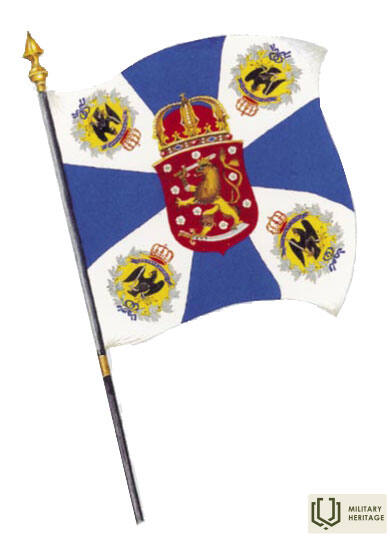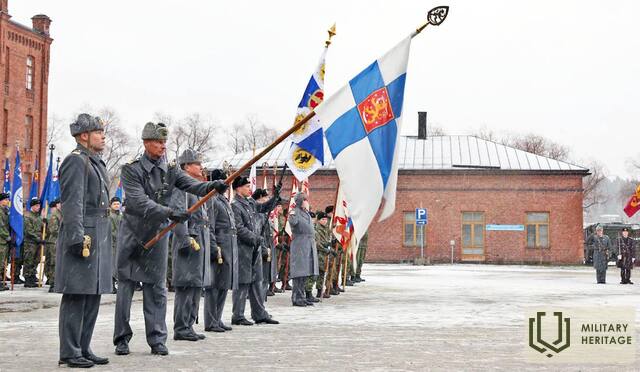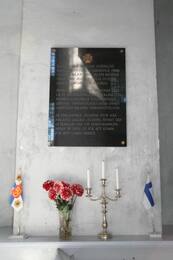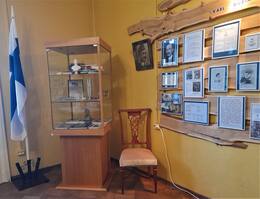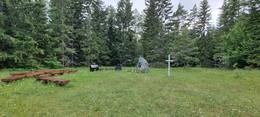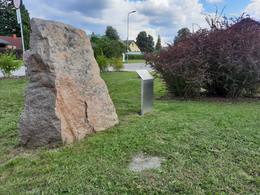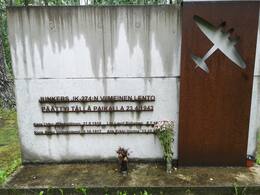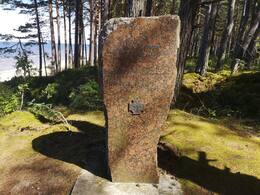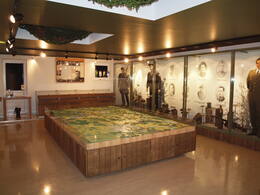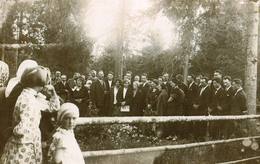Suomijos jėgerių vėliavos pašventinimas Liepojos Šventosios Trejybės katedroje
Pirmoji Nepriklausomos Suomijos vėliava buvo pašventinta 1918 m. Liepojoje, Šventosios Trejybės bažnyčioje, kur suomių jėgeriai prieš išvykdami namo prisiekė ištikimybę teisėtai Nepriklausomos Suomijos vyriausybei.
Pirmoji Nepriklausomos Suomijos kariuomenės vėliava buvo pašventinta 1918 m. vasario 13 d. Liepojoje, Šventosios Trejybės bažnyčioje. Suomijos jėgeriai prisiekė ištikimybę teisėtai Nepriklausomos Suomijos vyriausybei.
Kitą naktį pagrindinis bataliono kontingentas išvyko namo. Į Vaasą jie atvyko 1918 m. vasario 25 d.
Helsinkyje jėgerių vėliava pirmą kartą buvo iškelta 1918 m. gegužės 16 d., per paradą, skirtą Nepriklausomybės karo pabaigai paminėti. Vėliava plevėsavo priešais Suomijos jėgerių pulką. Pulkui vadovavo buvęs bataliono pagrindinio pulko vadas pulkininkas leitenantas Erikas Järnströmas.
Suomijos gynybos pajėgų paraduose Jägerio vėliava užima garbingą vietą iškart po nacionalinės vėliavos. Nepriklausoma Suomija prisimena savo kovotojus.
https://maavoimat.fi/en/-/jaakareiden-tyo-elaa-puolustusvoimassa
https://jp27.fi/auf-den-spuren-der-jaeger/die-jaegerfahne/?lang=de
Susijusi laiko juosta
Susijusios vietos
Atminimo lenta suomių jėgeriams Šv. Trejybės katedroje Liepojoje
Suomijos jėgerių atminimo lenta yra Liepojos Šventosios Trejybės katedroje, Lielā iela 9.
Suomijos jėgeriai buvo Vokietijos imperijos dalinys, suformuotas iš Suomijos savanorių, kuris, pasivadinęs 27-uoju karališkuoju Prūsijos jėgerių batalionu, dalyvavo Pirmojo pasaulinio karo mūšiuose Latvijos rytų fronte 1916–1917 m.
Pirmojo pasaulinio karo metu Suomijos Didžioji Kunigaikštystė buvo Rusijos imperijos dalis, ir daugelis suomių siekė Vokietijos pergalės kare, kad paskatintų nepriklausomos valstybės sukūrimą. 1914 m. lapkričio 20 d. Helsinkyje buvo įkurtas Suomijos nepriklausomybės judėjimas, kuris taip pat planavo suformuoti nepriklausomos valstybės ginkluotąsias pajėgas. Kai Vokietijos vyriausybė 1915 m. sausį patvirtino esanti pasirengusi apmokyti suomius, prasidėjo savanorių verbavimas, o iki 1916 m. pavasario Vokietijoje buvo dislokuota beveik 2000 kareivių, kurie buvo pavadinti 27-uoju Karališkųjų Prūsijos jėgerių batalionu.
Nuo 1916 m. birželio mėn. batalionas buvo Rygos fronte, kur buvo perkeltas į Liepoją, ir veikė iki 1917 m. kovo mėn. Po Vasario revoliucijos Rusijos imperija pradėjo byrėti, o 1917 m. gruodžio 6 d. Suomijos parlamentas paskelbė nepriklausomybę.
1918 m. vasario 13 d. batalionas Liepojos Šv. Trejybės bažnyčioje prisiekė ištikimybę Suomijai. 1918 m. vasario 15 d. batalionas laivu išplaukė iš Liepojos uosto, kad grįžtų namo į Vazos uostą ir dalyvautų Suomijos pilietiniame kare prieš raudonuosius, kurie 1918 m. sausio 27 d. įvykdė valstybės perversmą. Gerai apmokyti ir kovos patirties turintys jėgeriai sudarė Suomijos nacionalinės armijos branduolį, o nemaža dalis jų Antrojo pasaulinio karo metu tapo vadais.
Bataliono vėliava, pašventinta Šventosios Trejybės bažnyčioje, tapo pirmąja nepriklausomos Suomijos vėliava.
Aprikių muziejaus kolekcijos ir raudonųjų partizanų veiklos zonos
Aprikių dvare įsikūręs Aprikių muziejus, kurio ekspozicijos pasakoja apie senovės regiono istoriją. Muziejuje eksponuojama ekspozicija apie Suomijos karinį veikėją Karlą Gustavą Mannerheimą – 175 muziejaus eksponatai, interaktyvus stendas „KGMannerheimas ir Apriki“ (trimis kalbomis – latvių, anglų ir suomių) su 6 skyriais – apie Aprikių dvarą, apie KGMannerheimą kaip vadą Žiemos kare, apie Suomijos laisvės mūšių vadą ir apie jo ryšį su Aprikais.
Muziejuje taip pat eksponuojami Antrojo pasaulinio karo eksponatai su vokiečių ir Raudonosios armijos simbolika, taip pat žemėlapis (raudonųjų partizanų veiklos zonos) ir raudonųjų partizanų aprašymai.
Aprikku dvaro (Apprikken) pastatų barokinis ansamblis iš pradžių buvo suformuotas prie Alokste upės XVIII a. XX a. pradžioje. Dvaro savininkas buvo Carlas Gustavas Mannerheimas, vėliau tapęs Suomijos prezidentu ir žinomas kaip legendinės Mannerheimo linijos – įtvirtinimų sistemos Žiemos karo metu – autorius.
Ingrų suomių memorialinė vieta Põllküla mieste
Artėjant nuo Kersalu, prieš Põllküla geležinkelio pervažą, miško kelias pasuka į dešinę. Palei šį kelią, apie 200 m atstumu, miško proskynoje, yra memorialinė vieta.
1942–1944 m. iš Sovietų Sąjungos į Suomiją buvo evakuota daugiau nei 63 000 Ingrijos-Suomių karo pabėgėlių. Dauguma jų buvo laikinai apgyvendinti karantino ir pabėgėlių stovyklose, esančiose Põllküla, taip pat Kloogoje ir Paldiski. Evakuotieji į Suomiją buvo perkelti per Paldiski uostą.
Manoma, kad vien per Põllküla stovyklą praėjo kelios dešimtys tūkstančių žmonių. Žmonės stovykloje praleisdavo nuo kelių savaičių iki kelių mėnesių. Jie gyveno pastatuose, pastatytuose Raudonajai armijai 1939–1940 m. Gyvenimo sąlygos buvo sunkios, jie kentėjo nuo maisto trūkumo, šalčio, drėgmės ir įvairių infekcinių ligų. Dėl to stovykloje buvo didelis mirtingumas. Manoma, kad stovykloje žuvo apie tūkstantis ingrų suomių.
1944 m. rugsėjo 19 d. pasirašytos paliaubos, kuriomis baigėsi Tęstinio karo Suomijoje sutartis, įpareigojo Suomiją išduoti Sovietų Sąjungai Ingrijos suomius, kurie buvo Sovietų Sąjungos piliečiai. 1944–1945 m. į Sovietų Sąjungą buvo repatrijuota apie 56 000 žmonių.
Põllkülos memoriale yra atminimo lenta žuvusiems ir evakuacijai vadovavusiam Penčiui Kaiterai.
Atminimo akmuo suomių savanorių pulkui „Šiaurės berniukai“
Įsikūręs Alūksnėje, Jāņkalna gatvėje 52, šalia Alūksnės siaurojo geležinkelio stoties.
2019 m. vasario 23 d., minint Latvijos Nepriklausomybės karo šimtmetį, Nepriklausomybės kovos tradicijų asociacijos (Suomija) iniciatyva buvo sukurta speciali atminimo vieta Suomijos savanoriams, žuvusiems už Latvijos nepriklausomybę, pagerbti, kurioje istorinius įvykius liudija specialus riedulys ir informacinė lenta. Atminimo akmuo į Alūksnę atkeliavo iš Suomijos – Salpos linijos, kuri buvo nutiesta 1940–1944 m., siekiant apsaugoti rytinę Suomijos sieną. 1200 km ilgio Salpos linija yra viena žymiausių nepriklausomos Suomijos gynybos linijų, taip pat vienas stipriausių ir geriausiai išsilaikiusių tokio tipo gynybos statinių Europoje po Antrojo pasaulinio karo.
Į Alūksnę atgabentas akmuo simbolizuoja dviejų tautų – suomių ir latvių – kovą už savo nepriklausomybę. Suomijos savanorių pulkas „Šiaurės berniukai“ išvyko padėti latviams ginti naujosios Latvijos valstybės laisvę. 1919 m. vasario 21 d. „Šiaurės berniukai“ dalyvavo įnirtingose kovose Alūksnės (Marienburgo) apylinkėse. Po penkias valandas trukusių mūšių netoli Alūksnės geležinkelio stoties suomiai užėmė Alūksnę. Šiame mūšyje žuvo 23 suomių savanoriai, daugelis buvo sužeisti.
Suomijos pilotų atminimo vieta
Įsikūręs Lilaste-Saulkrastų greitkelio pakraštyje, šalia „Viada“ degalinės.
Memorialas buvo įkurtas 2013 m. Suomijos karinių oro pajėgų lėktuvo katastrofos vietoje 1943 m. Per katastrofą žuvo keturi Suomijos armijos kariai, skridę iš Vokietijos į Suomiją. Paminklo įrengimas, projektavimas ir statyba buvo visiškai Suomijos atstovų iniciatyva. Suomijos karo pilotai tradiciškai statyti memorialus lėktuvų katastrofų vietose.
1943 m. Suomija iš Vokietijos įsigijo 24 modernius „Junker“ bombonešius. Jie buvo skirti papildyti Suomijos armijos oro pajėgas moderniais orlaiviais. Gamykla pristatė orlaivius 1943 m., o apmokius pilotus, jie buvo perduoti Suomijai. Vieno orlaivio skrydis baigėsi tragiškai. Dėl techninių defektų pilotai buvo priversti ieškoti vietos avariniam nusileidimui. Lėktuvas prarado aukštį, atsitrenkė į medžius, sudužo miške ir užsidegė. Suomijos pilotai buvo palaidoti vokiečių armijos kapinėse Rygoje vokiečių okupacijos Latvijoje metu. Vėliau jie buvo perlaidoti tėvynėje.
Įdomu tai, kad vienas moderniausių tuo metu Latvijoje pagamintų lėktuvų 1938 m. taip pat sudužo Suomijoje. Jį pilotavo Latvijos ir Suomijos armijų pilotai – K. Lešinskis ir F. Kuopameki.
Paminklas suomių jėgerių-saperių atminimui
Įsikūręs Engurės savivaldybėje, A10 greitkelio pakraštyje, netoli Smārdės smuklės.
Memorialas yra lauke priešais Smårde barą, kur 1916 m., Pirmojo pasaulinio karo metu, įvyko Smårde mūšis. Kovose Vokietijos armijos sudėtyje dalyvavo suomių jėgerių inžinerinė kuopa (apie 200 vyrų). „Smårde diena“ tapo oficialia Suomijos armijos karo inžinierių švente, kuri švenčiama ir šiandien.
Suomijos jėgeriai buvo Vokietijos armijos dalinys, suformuotas Pirmojo pasaulinio karo metu. Juos daugiausia sudarė nacionalistiškai nusiteikę suomių savanoriai iš Rusijos imperijos ir Suomijos. Smårde mūšis buvo vienas reikšmingiausių suomių jėgerių puolimo mūšių, kuriame tuo metu buvo naudojama nauja taktika.
Praėjus mėnesiui po šio įvykio, Rusijos armija puolė vokiečių armiją netoli Smārdės. Latvijos koviniai daliniai atliko Smārdės apylinkių žvalgybą, nutiesė tiekimo kelią „Latvijos kelią“ per pelkę ir dalyvavo kovose. Mūšiuose žuvo apie 300 latvių kovotojų. Kaip ir suomių jėgeriai vokiečių armijoje, latvių šauliai Rusijos armijoje buvo savo nacionalinių valstybių ir armijų kūrėjai.
Suomių vaikinų kambarys
Šis muziejaus kambarys yra Saadjervės gamtos centre, mažame Äksi miestelyje.
Jis buvo atidarytas 2002 m. Suomijos berniukų asociacijos, Tartu savivaldybės ir Suomijos valstybės vardu ir remiant.
Jame pateikiama Antrojo pasaulinio karo metu Suomijoje ir Estijoje vykusių mūšių, kuriuose dalyvavo suomių berniukai, apžvalga. Čia pamatysite maketą, kuriame pavaizduoti Jegevos ir Tartu apskrityse vykę mūšiai, suomių berniukų uniformos, įranga, ginkluotė, kariniai apdovanojimai, asmeniniai daiktai ir nuotraukos. Bunkeris taip pat atviras lankytojams.
Įėjimas nemokamas.





